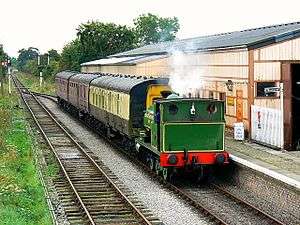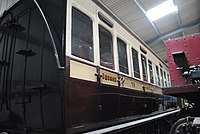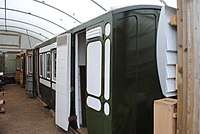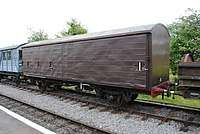Swindon and Cricklade Railway
The Swindon & Cricklade Railway is a heritage railway in Wiltshire, England, that operates on a short section of the old Midland and South Western Junction Railway line between Swindon and Cricklade.
| Swindon and Cricklade Railway | |
|---|---|
 Slough Estates No.3 with a service train at Hayes Knoll | |
| Locale | Swindon, Wiltshire, England |
| Terminus | Blunsdon |
| Coordinates | 51.607°N 1.8436°W |
| Commercial operations | |
| Original gauge | 4 ft 8 1⁄2 in (1,435 mm) standard gauge |
| Preserved operations | |
| Length | 2.5 miles (4.0 km) |
| Preserved gauge | 4 ft 8 1⁄2 in (1,435 mm) standard gauge |
| Preservation history | |
| 1978 | Preservation Society formed |
| 1984 | S&CR granted Light Railway Order (following reconstruction of the line) |
| 1985 | S&CR re-opened and runs its first trains |
| 2008 | South Meadow reached |
| 2012 | Taw Valley Halt reached |
| 2014 | Taw Valley Halt officially opened |
| Headquarters | Blunsdon |
| Swindon & Cricklade Railway | ||||||||||||||||||||||||||||||||||||||||||||||||||||||||||||||||||||||||||||||
|---|---|---|---|---|---|---|---|---|---|---|---|---|---|---|---|---|---|---|---|---|---|---|---|---|---|---|---|---|---|---|---|---|---|---|---|---|---|---|---|---|---|---|---|---|---|---|---|---|---|---|---|---|---|---|---|---|---|---|---|---|---|---|---|---|---|---|---|---|---|---|---|---|---|---|---|---|---|---|
| ||||||||||||||||||||||||||||||||||||||||||||||||||||||||||||||||||||||||||||||
Swindon and Cricklade Railway is a registered charity.[1]
Preservation history
The Swindon & Cricklade Railway Preservation Society was formed by a group of enthusiasts in November 1978 to reconstruct and preserve a section of the Midland & South Western Junction Railway that ran from Andover, Hampshire, to Cheltenham, Gloucestershire.
The volunteer-operated railway has reopened three stations: Hayes Knoll, Taw Valley Halt and Blunsdon, the headquarters of the line. Hayes Knoll features a restored signalbox that is operational during special events and a running/restoration shed. The length of the restored line is a little under 2.5 miles (4.0 km).
The line extends north to South Meadow Lane (a few hundred yards from the site of a proposed Farfield Lane halt) near Cricklade, and south to Taw Valley Halt on the outskirts of Swindon, near Mouldon Hill Country Park.[2] A southern terminus, Mouldon Hill, is proposed within the park.[3]
Locomotives
Steam locomotives
| Number & Name | Class | Notes | Photograph |
|---|---|---|---|
| No. 2138 Swordfish | Andrew Barclay 0-6-0 ST | Built in 1941. Operational, returned to service in 2016 after restoration. | .jpg) |
| No. 2354 Richard Trevithick | Andrew Barclay 0-4-0 ST | Built in 1954. Undergoing a ten-yearly overhaul. | |
| No. 1464 MSC No. 70 | Hudswell Clarke 0-6-0 T | Built in 1921. Undergoing overhaul. | .jpg) |
| No. 3135 Spartan | Fablok TKh49 Class 0-6-0 T | Built in 1953. Awaiting overhaul. | .jpg) |
| No. 5619 | GWR 5600 Class 0-6-2 T | Built in 1925. On loan from the Telford Steam Railway.[4] |  |
| No. 5637 | GWR 5600 Class 0-6-2 T | No. 5637 was built in 1925. It entered traffic at Cardiff Cathays shed in late September 1925, but was transferred six weeks later to Barry shed and was used on local services in the Newport and Cardiff districts.
No. 5637 spent all its life in South Wales, being withdrawn from traffic in June 1964 and later sold to Woodham Brothers, arriving at Barry scrapyard in September 1964. In August 1974, No. 5637 became the 61st locomotive to escape from Barry, when it was sold to the Birmingham Railway Museum at Tyseley. In 1981 it was resold, without any restoration having been carried out, to Thamesdown Borough Council for leasing to the Swindon and Cricklade Railway. Some time after, it was purchased by a group of volunteers at the Swindon & Cricklade Railway. In 1998, after almost 18 years of restoration, No. 5637 was steamed for the first time since 1964. The locomotive was subsequently transferred by road to the East Somerset Railway for running in, and stayed there ever since. It has become the primary engine at the ESR, running most of the services. No.5637 has moved back to the Swindon and Cricklade railway in March. Its current boiler ticket expires in April 2020. |
 |
| No. 6695 | GWR 5600 Class 0-6-2 T | Built in 1928. Undergoing Overhaul, recently moved from the West Somerset Railway. | .jpg) |
| No. 35011 General Steam Navigation | SR Merchant Navy Class 4-6-2 | Built in 1944. Arrived in April 2019. Currently part of a scheme to restore the loco to as-built condition with air-smoothed casing and chain link valve gear.[5] |  |
Diesel locomotives
- BR Class 03 0-6-0 DM – 03 022. Returned to service in October 2019 after rebuild.
- BR Class 03 0-6-0 DM – D2152 – cut-down cab variant. In regular service.
- BR Class 97/6 0-6-0 DE – PWM651. Arrived from Strathspey Railway in August 2015. Operational.
- BR Class 08 0-6-0 DE – D3261. Restored to service in October 2010.
- BR Class 09 0-6-0 DE – 09 004. Undergoing overhaul. Intermittent service.
- BR Class 73 Bo-Bo electro-diesel Sir Herbert Walker No E6003. In service.
- Fowler 0-4-0 DM Woodbine No 21442. In service.
- Fowler 0-4-0 DM No 7342. In regular use on works trains.
- Fowler 0-4-0 DM No 422003. In service.
Diesel multiple units
Specialist vehicles
- TASC 45 No. 98504, built by Plasser & Theurer for British Rail. A four-wheel vehicle with side-tipping dropside rear body, crew cab with mess facilities and a HIAB crane on the rear. Used regularly on works trains and on galas.
- Wickham Railcar No 9031 (Type 27 Mk III, Works No. 8089), a small four-wheeled vehicle for departmental use.[7] Crew cab seating five. Smaller than normal railway vehicles to standard loading gauge, as it is roughly 6 feet (1.8 m) tall. Has no external couplings/drawbar or buffers. Undergoing overhaul, engine being replaced with that of a Peugeot 106.[8]
Vintage railway coaches
| Origin | Number | Type | Notes | Photograph |
|---|---|---|---|---|
| GWR | No. 7545 | GWR Toplight Brake corridor Tri-composite [9] | built 1907 – extensive restoration in progress |  |
| GWR | No. 3898 | GWR Toplight corridor third [10] | built 1920 – awaiting restoration. Later turned into a camping coach. | |
| TVR | No. 73 | Taff Vale Railway Composite coach. | built 1890 – restoration completed using ex Fruit D chassis. [11] |  |
| CR | No. 104 | Cambrian Railways Full Brake | Recovered from derelict property in North Devon in August 2018. Will run with No. 110 when complete. Now under restoration. [12] |  |
| CR | No. 110 | Cambrian Railways 1st/2nd composite | built 1894 – coach body being restored. [13] |  |
| NLR | No. 111 | North London Railway 1st class | Underframe suitable for 111 in stock. Work on rebuilding original frame has begun. [14] |  |
| GWR | No. 422 | Luggage Brake | New-build brake carriage being converted from a goods brake for use on the vintage trains with Taff Vale 73. This is due to the possibility of obtaining a vintage brake carriage being very slim. Possibility of entering service in 2019. |  |
Wagons
| Origin | Number | Type | Notes | Photograph |
|---|---|---|---|---|
| LMS | PBA27 | 4-wheel ventilated van | Unknown build date. Later used by the Port of Bristol Authority and numbered 27. Recently restored to operational condition and painted blue with a 'Jewson' logo. [15] |  |
| GWR | 27907, later 17980 | 4-wheel goods brake van | Likely an early date GWR Toad due to the spoked wheels. Heavily modified for passenger use. Previously at Swindon Steam Museum |  |
| Swindon and Cricklade Rly | 3 | 4-wheel weedkilling wagon | Converted from a four-wheel wagon underframe. Used for killing of weeds. [16] |  |
| GWR | 92953, later PBA61047 | Four-wheel China Clay Wagon | Built in 1913 at Swindon. Previously used by Port of Bristol Authority. [17] | .jpg) |
| BR | B 954937 | Four-wheel goods brake van | Built in 1959 at Faverdale. Operational [18] |  |
| BR | 200241 | Four-wheel non-ventilated van | Built in 1969 at Ashford. |  |
Stations of the S&CR line
| Station | Notes |
|---|---|
| Cricklade | Construction planned as part of northern extension |
| Farfield Lane | Construction planned as a temporary northern terminus until Cricklade station is built; at the site of a collapsed and in-filled bridge where Farfield Lane crosses the line |
| South Meadow Lane | Halfway point between Hayes Knoll and Farfield Lane; used as a return point to Hayes Knoll when running north from Blunsdon. No run-round loop, no platform facilities. A siding is planned but has yet to be laid. |
| Hayes Knoll | Depot and workshop; no road access |
| Blunsdon | Headquarters of the line |
| Taw Valley Halt | Opened in 2014. Used as a return point to Blunsdon when running south from Hayes Knoll, and is the current terminus of the line (until funding, planning and issues with the existing utilities can be overcome to allow access to Mouldon Hill station to be built) |
| Mouldon Hill | Construction planned as part of southern extension towards Swindon |
References
- Charity Commission. SWINDON AND CRICKLADE RAILWAY, registered charity no. 1067447.
- "The Line". Retrieved 15 November 2010.
- Pigott, Nick, ed. (July 2012). "Putting the Swindon in Swindon & Cricklade!". The Railway Magazine. Horncastle: Mortons Media Group. 158 (1335): 65. ISSN 0033-8923.
- "Steam". Swindon and Cricklade Railway. Retrieved 16 April 2019.
- "35011 General Steam Navigation". Swindon and Cricklade Railway. Retrieved 16 April 2019.
- Robins, Tina. "Blaze destroys vintage train" (20 May 2016). Swindon Advertiser. Retrieved 21 May 2016.
- "News – Wickham Trolleys – October 2009". ontrackplant.com.
- "9031 – Wickham Type 27A Trolley". Retrieved 28 October 2010.
- http://www.cs.rhrp.org.uk/se/CarriageInfo.asp?Ref=235
- http://www.cs.rhrp.org.uk/se/CarriageInfo.asp?Ref=189
- http://www.cs.rhrp.org.uk/se/CarriageInfo.asp?Ref=24
- http://www.cs.rhrp.org.uk/se/CarriageInfo.asp?Ref=16066
- http://www.cs.rhrp.org.uk/se/CarriageInfo.asp?Ref=6063
- http://www.cs.rhrp.org.uk/se/CarriageInfo.asp?Ref=5679
- http://www.ws.rhrp.org.uk/ws/WagonInfo.asp?Ref=11100
- http://www.ws.rhrp.org.uk/ws/WagonInfo.asp?Ref=7159
- http://www.ws.rhrp.org.uk/ws/WagonInfo.asp?Ref=7143
- http://www.ws.rhrp.org.uk/ws/WagonInfo.asp?Ref=9681
External links
| Wikimedia Commons has media related to Swindon and Cricklade Railway. |